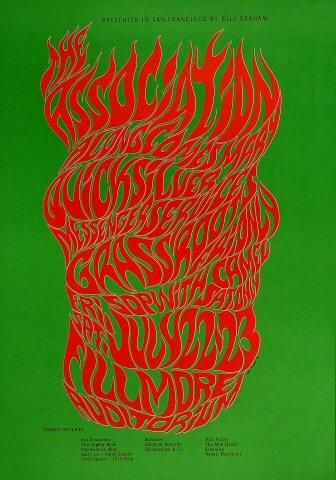The Association Poster

Image may not exactly match item shipped.
One of Wilson's most distinctive posters, BG018 captures the fiery intensity of the dance concert experience. Flaming letters lick skyward in a human head shape, and top billing, The Association, blows off the lid.
The 1st printing is on uncoated stock with a white reverse, and the Wes Wilson credit and ticket outlet information are dark red/brown. There are very slight variations within this original, pre-concert run in that stock thickness is between .0065" to .0080". These first printings range from having a pronounced black light glow to none at all. This poster measures 14 1/16" x 20 3/16".
The 2nd printing, produced after the concert, has a blue reverse and olive green background. "#18" does not appear as it does in the 3rd printing, and this poster measures 13 3/4" x 19 3/4".
The 3rd printing, also a post-concert version with a blue reverse, is identified by its rich, dark green background. "#18" appears after "Wes Wilson '66", and the poster measures 14" x 20".
The 4th printing has a white reverse and "Wes Wilson '66" appears in bright red, matching that of the image lettering. This post-concert printing is on coarse uncoated stock and measures 13 7/8" x 20 1/8".
The 5th printing has a white reverse with "Wes Wilson '66" in dark red and is printed on smooth uncoated index paper stock thicker than .009". It measures 13 15/16" x 20" and was printed after the concert.
The 6th printing is on #80 matte cover stock and has "W 2021" in the lower right-hand margin. It was printed in 2021 by Wolfgang's in a 100 copy run. This reprint measures 14" x 20".
When the Avalon Ballroom and Bill Graham's Fillmore Auditorium began to hold weekly dance concerts, Wilson was called upon to design the posters. He created psychedelic posters from February 1966 to May 1967, when disputes over money severed his connection with Graham. Wilson pioneered the psychedelic rock poster. Intended for a particular audience, "one that was tuned in to the psychedelic experience," his art, and especially the exaggerated freehand lettering, emerged from Wilson's own involvement with that experience and the psychedelic art of light shows.